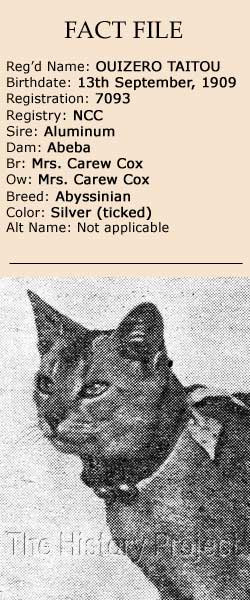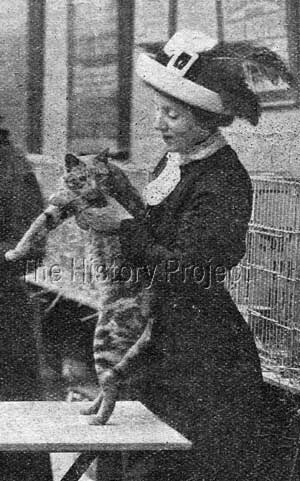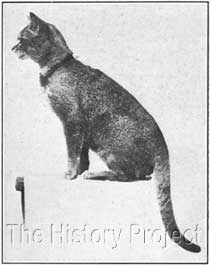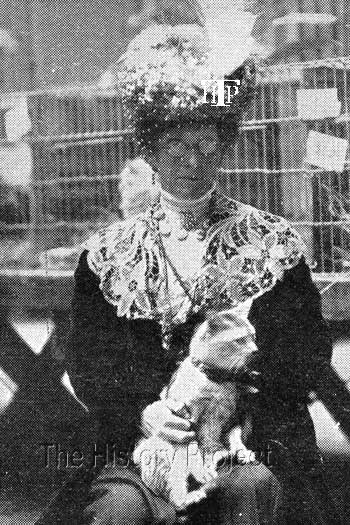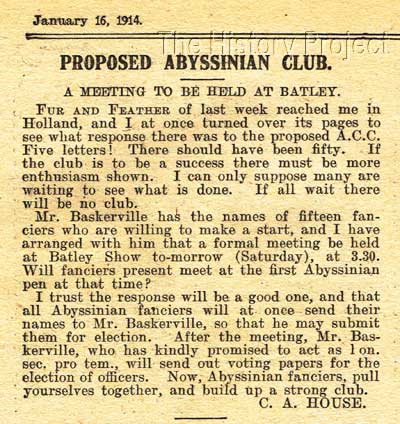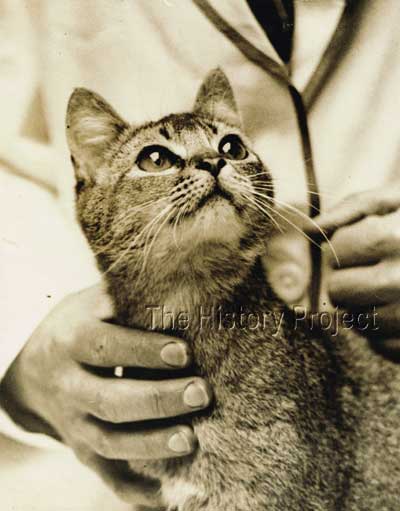 | |||||||||||||||||||









|
OUIZERO TAITOU (1909)PHOTOS | SOCIAL MEDIA | REFERENCES
HISTORICAL BACKGROUND:It is fair to say that, from the beginning, the Abyssinian Cat, although unique in its foreign beauty and in its ticked coat, had a very rough time of it getting established at all. Their numbers were very few, although a fine example, in a female named 'Zula', was exhibited at the Second Crystal Palace Cat Show in December of 1871, where she took a third prize. She had been taken as a captive in the late Abyssinian War, at the conclusion of which she was brought back to England, where she was owned by Mrs. Captain Barrett Lennard.3 The first Abyssinians to appear in the National Cat Club Stud-book and Register were 'Queen Jumbo', (NCC: 1561) 'Sedgemere Bottle', (NCC: 2314) and 'Sedgemere Peaty', (NCC: 2315). No date of birth is given for 'Queen Jumbo' but her death is recorded as 1893.4 She was a Silver Abyssinian, owned by Mrs. Herring, the sister-in-law of Harrison Weir. 'Sedgemere Bottle', a male, whose colour is not given, was born in 1892. He was originally owned by Mr. Swinyard, but by the time of his registration was in the ownership of Mr. Sam Woodiwiss. 'Sedgemere Peaty', a female, whose colour is also not recorded, was born in October 1894 (a year after the death of 'Queen Jumbo') and her ownership followed that of 'Sedgemere Bottle'. 'Peaty' was later owned by Mr. H.C. Brooke, and from a black and white photo taken of her while under his stewardship, it is difficult to ascertain her colour. The colour appears paler than her Manx counterparts in the same image, but we are fortunate to have this record of her colour by Mr. Brooke: "Probably the best Abyssinians ever seen in this country were Sedgemere Bottle and Sedgemere Peaty, the property of Mr. Sam Woodiwiss. They were, as far as I know, not related, and if this be the case it is really remarkable how two such specimens were obtained. They were very much the colour of a hare. Peaty ended her days in my possession, and I have always regretted not having preserved her skin, to at least retain her glorious colour, though her beautiful sinuous form and delicate limbs can hardly be imagined by those who have not seen her."5 In fact, much conjecture exists as to the colours of many of the early Abyssinians, and it seems probable that a good many of them were in fact silver, as was 'Ouizero Taitou'. Names suggestive of the colour abound among the earliest cats, such as 'Aluminium', 'Platinum', 'Quicksilver', 'Silver Memelik', 'Silver Fairy', and 'Silver Ideal' to name just a few.6 In The Book of The Cat, Mr. Brooke, who was a strong supporter of 'foreign varieties' gives a description of the expected colour: "The colour of the Abyssinian should be a sort of reddish-fawn, each individual hair being 'ticked' like that of a wild rabbit - hence the popular name of 'bunny cat'. The great difficulty in breeding these cats is their tendency to come too dark and too heavily striped on the limbs; the face should be rather long, the tail short and thick, and the ears large.
"The Abyssinian should not be a large coarse cat. A small cat of delicate colouring and the above mentioned body properties is by far to be preferred to the large, coarse, dark specimens one sees winning under all-round judges, merely because of their size."7 It was Mr. Brooke's view that the foreign varieties needed to be judged by Specialist Judges with a specific knowledge of the variety: "At the best, knowledge of the different varieties of foreign cats is absolutely in its infancy. It should be the aim of large shows to provide, whenever possible, judges for these interesting strangers who do really take some interest in them. I am bound to say that of late years the National Cat Club has done its best to meet the wishes of owners in this respect, and with gratifying results, as witness the good classes at the Crystal Palace show, where there were no fewer than eleven Abyssinians penned - a record number!*7 (Editor's note: *Crystal Palace Show of 1902!) PARENTAGE & OWNERSHIP:
Ras Kasar
Aluminum
| Rocksham
Eng Ch Ouizero Taitou, Sept-13-1909, Silver, M
| Unknown
Abeba
Unknown
'Ouizero Taitou' was born 13th September, 1909. He was sired by 'Aluminium' (NCC: 4463) (born in 1905) and out of 'Abeba'. We have no confirmation of the colour of 'Aluminium' although his name is certainly suggestive of being a Silver, but we do have his parentage, his sire being 'Ras Kasar' and his dam 'Rocksham'. For 'Abeba' we have no other information.
The breeder of 'Ouizero Taitou' was Mrs. Constance Carew-Cox, who was also the breeder of his sire 'Aluminium'. Although Mr. Brooke personally regarded the Silver variety an alien colour in the Abyssinian breed, preferring instead the lovely ruddy undercoat, he never-the-less has nothing but praise for the work done by Mrs. Carew Cox, whom he almost single-handedly credits for the survival of the Abyssinian breed, through its many and various trials and tribulations: "About thirty years ago some very good Abyssinians were shown by the late Mr. Heslop, of Darlington; Mrs. Alice Pitkin also exhibited some fair specimens, many of hers, however, being too dark and "British Ticks" in type. Later Mrs. Clark, of Bath, possessed many excellent specimens. "I bred quite a number at that period, perhaps the best being 'Chelsworth Peaty', who greatly interested Queen Alexandra, then Princess of Wales, when I exhibited her, suckling a ferret, at a Botanic Gardens Show. I sent quite a number to Continental menageries and fanciers; early in the century, however, I gave up all dog and cat breeding, and left London for the West Country to devote myself entirely to hunting. "Had not Mrs. Carew-Cox about this time devoted herself to the breed I very much fear it would, ere now, have become extinct. Neglected - Heaven knows why - by the Fancy at large in an inconceivable manner, this beautiful and interesting breed certainly owes its existence to-day mainly to the devoted care and affection bestowed upon it by Mrs. Carew-Cox, who for a quarter-of-a-century has fostered it in the face of discouragements which I verily believe would have "choked off" any other person in the Fancy. "Not for her the "big business" in stud fees, the "queued-up" queens, the cups and specials galore, which fall to the lot of many Long-hair breeders; no, in the face of rotten judging, lack of recognition, poor prizes, lack of market, and a heart-breaking mortality in kittens, this plucky lady has carried the Abyssinian flag triumphantly through. She cannot (or modestly will not?) tell me how many champions she has bred since some thirty odd years ago she fell in love with the first specimen she saw at an hotel at Winscombe, Somerset, where they were said to have been left by one who had been a traveller in "furrin parts". "Incidentally, I may mention that a good many years back Mrs. Carew-Cox published a couple of letters from a gentleman who had been shooting in Abyssinia, and who stated that he had there shot a pair of wild cats, whose skins he brought to England, and which seemed from the description to correspond in every way with our present-day exhibition specimens."5 What an amazing tribute to Constance Carew Cox from a man who was himself so highly respected in the world of cats! SIBLINGS & SHOWS:
There are two full older siblings of singular note for 'Ouizero Taitou'. These are 'Pepper' (a male), and 'Salt'(a female), born 25th October, 1907. They were also bred by Mrs. Constance Carew-Cox, and 'Salt' was duly exported along with her half-brother 'Aluminium II' (by 'Aluminium' ex 'Fancy Free') to Miss Jane Cathcart, in the United States. 'Fancy Free' (NCC:4934), it should be noted, was a Silver, and in an issue of Our Cats, dated 8th May 1909, she is listed as 'imported'. She is the dam of a number of sire-siblings to 'Ouizero Taitoo', all sired by 'Aluminium', which included: 'Aluminium II' and 'Quicksilver' (born 3rd September 1907), and 'Silver Fairy' and 'Platinum of Thorpe' (born 2nd March, 1908).
Another sire sibling of note, is 'Ras Dashan', (born 25th April, 1908), sired by 'Aluminium' and out of 'Linga'. As far as can be ascertained, 'Ras Dashan' was a 'Usual' or 'Ruddy' Abyssinian like his dam. He was of course, bred by Mrs. Carew-Cox and firstly owned by Mrs. K. Palmer, later transferring to the ownership of Mrs. E. A. Clark. From the Supplement to the Register we find 'Ras Dashan' (while owned by Mrs. Clark), exhibited a number of times against 'Ouizero Taitou'. Although 'Taitou' defeated him often, there were times when 'Ras Dashan' came out on top, and took the Best of Breed win. Show Wins: Our records of 'Taitou's' shows wins are drawn from both the Stud Book and its Supplement as well as an article in Fur and Feather, and include: 2nd Richmond 1911; 1st Hounslow 1911; 1st NCC (National) 1911; 3rd Richmond 1912; 1st Hounslow 1912; 1st NCC (National) 1912; 1st Richmond 1913; 1st NCC (National) 1913; 2nd Richmond 1914. In addition, we are advised that he gained wins at Westminster, and at Cambridge in August 1913 he won the Cup for Best Cat in Show, very possibly the first verifiable 'Best Cat' win by an Abyssinian!
BREEDING & PROGENY:'Taitou' appears to have been a reliable working stud male, but only a handful of progeny can be found in official records. The following are those, listed in chronological order: 'TESSAMA', Abyssinian Female born 23rd March, 1911. PHOTOS:
SOCIAL MEDIA :It was, in fact, many years before an Abyssinian Cat Club was finally able to be established in 1929, founded by Major E. Woodiwiss. At that time, the annual subscription was set at five shillings and we are informed that it remained at this level, with deteriorating value, well into the 1950's. However, this was not the first attempt to establish a club, as can be verified by the notice below, which was given by the well-known judge and author, Charles A. House, in Fur and Feather on 16th January, 1914.
In addition, we are also informed that the first Abyssinian Cat Club Show was held on Wednesday 12th March, 1931, and that twenty cats and kittens were entered and were judged by Mr. Sam Woodiwiss. However, the true date of that show appears to have been exactly one year earlier, as is verified by the very brief article of news, published on 12th March 1930, (duly accompanied by the below photograph), which simply states:
In Summary: The story of 'Ouizero Taitou' is an interesting one. It reminds us firstly of the sheer dedication of his amazing breeder, to the survival of her chosen breed (one of several breeds she was passionate about!). It also reminds us that in the early days of the breed, the Silver Abyssinian was as populous in numbers as the Ruddy. It was the opinion of Mr. Brooke that the Silver was not a natural Abyssinian colour, but that was only his opinion and he was not the sole authority. He quickly dismisses the words of Harrison Weir on the subject, who alludes to the Silver variety in his notes on Abyssinians, published in 1889. Both agree that the cats are similar to those ancient cats which originated in Egypt, but how quickly it is forgotten that Egypt had silver shorthaired cats too! Mrs. Constance Carew-Cox did not necessarily share Mr. Brooke's view of the Silvers. She kept, bred and exhibited silvers with success, and no doubt passed on some for breeding, which is hardly indicative of someone who would consider that they do not hold merit. Just as today we hold precious the bold rufousing and undercoat of the modern ruddy Abyssinian, we should equally celebrate and hold precious the clear coated, unmarked and un-muddied, bright silver undercoat of a Silver Abyssinian. The story of the Abyssinian is one which epitomises the expression 'through trials to triumph'; for 120 plus years later, the Abyssinian cat is no longer the second class citizen of the feline world, struggling to hold its own. Abyssinians have taken 'CAT of the YEAR' in many Associations around the world and are now proudly shown on every continent! They are our link to the ancient cats of the past, have contributed their colour and pattern to breeds of the present, and are sure to be the forthright companions of mankind, well into the future. REFERENCES:
Registers associated with this article include The Incorporated Cat Fanciers Association of Great Britain (TICFAGB), National Cat Club (NCC), The Cat Club (CCR), Beresford Cat Club (BCC), Feline Federation Francaise (FFF), Siamese Cat Registry (SCR), US Register & Studbook for Cats (USR)including Supplement(USRS), The Studbook of the American Cat Association (ACA), and the Studbook & Register of the Cat Fanciers' Association (CFA).
| ||||||||||||||||||
Home | Cats | Gallery | Clubs | People | Artifacts | Articles | Updates | Contact Us ©The CFA Foundation, Inc and The Harrison Weir Collection
|
|||||||||||||||||||
